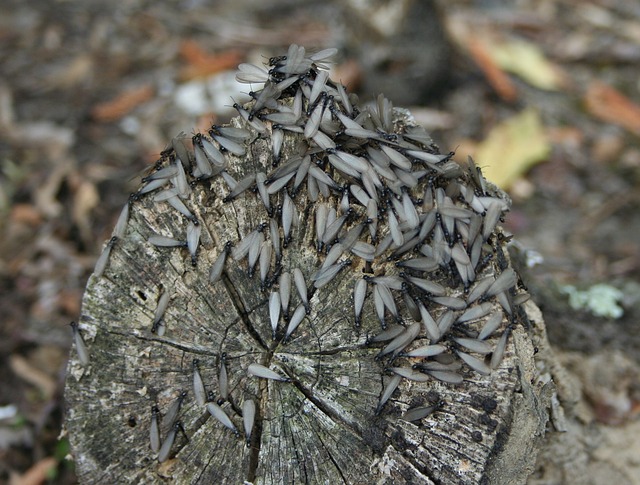Have you ever wondered if it’s safe to burn firewood that has been infested with termites? It’s a common concern for those who rely on firewood as a source of warmth or for cozy evenings by the fireplace.
Burning firewood with termites is not recommended. Termite-infested wood is compromised, making it prone to fire hazards and potentially releasing harmful gases when burned. You can also be bringing a termite infestation into your home. It’s safer to avoid burning and focus on proper termite elimination and responsible disposal methods.
In this article, I’ll delve into the topic and discuss the risks and safety concerns associated with burning termite-infested wood. So, let’s explore this issue together and find out what you need to know in detail.
Understanding the Termite Problem
Before I delve into the specifics of burning termite-infested firewood, let’s take a moment to understand the termite problem and why it can be a cause for concern. Termites are small insects that feed on wood and cellulose materials, making them a homeowner’s nightmare. Their ability to cause extensive damage to wooden structures is well-known, and firewood is no exception.
When termites infest firewood, they burrow into the wood, creating intricate networks of tunnels and passages as they feed on the cellulose. Over time, their activity weakens the structural integrity of the wood, making it more susceptible to crumbling or breaking apart. This compromised wood poses risks not only in terms of safety but also in terms of potential hazards when burned.
If you’re wondering how termites end up in firewood in the first place, it’s important to note that these insects can infest trees and logs long before they are harvested and used as firewood. Termites are naturally present in the environment, and they can infest standing trees or fallen logs. When firewood is collected from infested sources or stored near termite-infested areas, there’s a high likelihood of termites making their way into the woodpile.
The presence of termites in firewood may go unnoticed until signs of infestation become visible. These signs can include small holes or tunnels in the wood, sawdust-like frass near the woodpile, or weakened sections that crumble easily. It’s crucial to be vigilant and inspect firewood regularly to detect termite infestations early on.
Addressing termite-infested firewood is essential to prevent further damage and potential risks. Ignoring the problem or attempting to burn the infested wood can have serious consequences.
In the following sections, I’ll explore the safety concerns associated with burning termite-infested wood and provide guidance on proper disposal methods to protect your home and the environment.
The Safety Concerns of Burning Termite-Infested Wood
When it comes to burning termite-infested wood, there are significant safety concerns that should not be taken lightly. It’s crucial to understand these risks to ensure the well-being of yourself, your home, and the environment.
Fire Hazards: Termites weaken the structural integrity of wood by burrowing through it and creating tunnels. As a result, termite-infested wood is more prone to crumbling, breaking apart, and catching fire more easily than healthy wood. When you burn compromised wood, there is an increased risk of sparks, embers, or flaming debris igniting nearby flammable materials, such as furniture, carpets, or curtains. This can quickly lead to a dangerous and uncontrollable fire. To protect yourself and your property, it’s best to avoid burning termite-infested firewood altogether.
Air Pollution and Health Risks: Burning termite-infested wood can release harmful gases and chemicals into the air. As termites feed on wood, they produce byproducts that can be released when the wood is burned. These emissions can contribute to poor indoor and outdoor air quality, posing risks to your health and the environment. Breathing in the fumes from burning termite-infested wood may irritate the respiratory system and worsen existing conditions such as asthma or allergies. Additionally, the release of pollutants into the environment can have a negative impact on air quality and contribute to environmental degradation.
Considering these safety concerns, it’s crucial to prioritize the safety of your home and the well-being of your loved ones by avoiding the burning of termite-infested wood. The risks associated with fire hazards and air pollution outweigh any potential benefits. Instead, focus on appropriate methods for addressing termite infestations and disposing of the infested wood responsibly.
I’ll explore these aspects further in the next sections.
Proper Disposal of Termite-Infested Wood
When you discover termite infestations in your firewood, it’s essential to handle the situation responsibly and ensure the proper disposal of termite-infested wood. Burning the wood is not a recommended method for termite removal due to the safety concerns we discussed earlier. Here are some steps you can take for the proper disposal of termite-infested wood:
Remove Termites from Firewood
Before disposing of the infested wood, it’s important to eliminate the termites to prevent the spread of the infestation. There are a few effective methods you can consider:
- Solar Treatment: Place the infested firewood under direct sunlight for several days. The heat from the sun will help kill the termites and their eggs. Make sure to cover the wood with a clear plastic sheet to trap the heat.
- Freezing: If you live in an area with cold temperatures, you can place the infested firewood in a freezer or a cold storage area for a few days. The low temperatures will kill the termites and halt their activity.
It’s important to note that these methods may not eliminate all the termites, so it’s advisable to seek professional advice from pest control experts to ensure thorough treatment.
- Contact Local Pest Control or Waste Management Services: Once the termites have been eliminated from the firewood, it’s time to dispose of them safely. Contact your local pest control or waste management services to inquire about the proper disposal procedures for termite-infested wood in your area. They will provide specific instructions on how to handle and dispose of the wood responsibly, considering local regulations and environmental considerations.
- Avoid Reusing or Recycling Infested Wood: It’s crucial not to reuse termite-infested wood for any purpose. Even if the termites have been eliminated, the structural integrity of the wood may still be compromised. Avoid using it for construction, DIY projects, or even as mulch in your garden. Instead, opt for new, untreated wood from reliable sources to ensure its quality and integrity.
Responsible disposal protects not only your property but also the surrounding environment and other wooden structures from potential infestations. Prioritizing the eradication and responsible handling of termite-infested wood is crucial for maintaining a safe and termite-free environment.
Preventing Termite Infestations in Firewood
Prevention is always better than dealing with the consequences of a termite infestation. To protect your firewood from termites and minimize the risk of infestation, here are 5 preventive measures you can take.
1. Proper Storage Practices
- a. Elevate Woodpiles: When storing firewood, it’s important to elevate the woodpile off the ground. This helps create a barrier between the wood and the soil, making it more difficult for termites to access the woodpile.
- b. Distance from Buildings: Keep your firewood pile at a reasonable distance from your home or any other wooden structures. Aim for a minimum distance of 20 feet to reduce the likelihood of termites spreading to nearby buildings.
- c. Use a Rack or Platform: Consider using a firewood rack or platform to stack your wood. This allows for better airflow and helps keep the wood dry, discouraging termite activity.
2. Inspect Firewood Regularly
Regular inspections are crucial for the early detection of termite activity in firewood. Take the time to inspect your woodpile, paying attention to signs of termite infestation such as small holes, tunnels, or frass (termite droppings). If you notice any signs, take immediate action to address the issue.
3. Avoid Storing Infested Wood
If you come across firewood that is already infested with termites, it’s important not to store it with your healthy firewood. Remove the infested wood from your property and dispose of it properly, following the appropriate methods we discussed earlier.
4. Consider Treated Firewood
When purchasing firewood, consider opting for treated wood that has been treated with termite-resistant chemicals. Treated firewood can help deter termites and minimize the risk of infestation.
5. Seek Professional Advice
If you live in an area prone to termite infestations or if you’ve had previous termite problems, it’s a good idea to consult with a pest control professional. They can provide specific recommendations tailored to your situation and offer preventive treatments to protect your firewood and property from termites.
Taking proactive steps to safeguard your firewood will ensure that you can enjoy its warmth and coziness without worrying about unwanted termite guests.
Conclusion
In conclusion, when it comes to burning firewood with termites, it’s important to prioritize safety, both for yourself and the environment. Termite-infested wood poses significant risks, including fire hazards and potential air pollution. The weakened structural integrity of termite-infested wood increases the chances of fires and can release harmful gases when burned.
Instead of burning termite-infested firewood, focus on proper disposal methods and preventive measures. Removing termites from firewood through solar treatment or freezing can help eliminate the infestation. However, it’s essential to consult with pest control professionals for expert guidance on effective termite eradication techniques.
Proper disposal of termite-infested wood involves contacting local pest control or waste management services to ensure safe and responsible disposal in accordance with local regulations. Avoid reusing or recycling infested wood to prevent the spread of termites and maintain the integrity of wooden structures.
Prevention is key to avoiding termite infestations in firewood. Elevate woodpiles, keep them away from buildings, and inspect firewood regularly for signs of termite activity. Consider treated firewood as a preventive measure, and seek professional advice if you live in an area prone to termite problems.
By prioritizing safety, responsible disposal, and prevention, you can enjoy the benefits of firewood without compromising your well-being or the health of your environment. Let’s be proactive in addressing termite-related issues and ensure a warm and cozy atmosphere while protecting your homes and surroundings.
Check my latest article: The Best And Worst Firewood For Your Fireplace: A Comprehensive Guide





